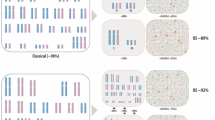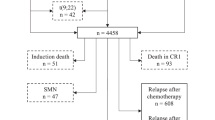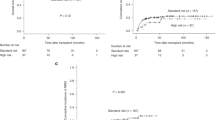Abstract
High hyperdiploidy (HeH, 51–65 chromosomes) is an established genetic subtype of acute lymphoblastic leukaemia (ALL). The clinical and cytogenetic features as well as outcome of HeH among adolescents and adults have not been thoroughly investigated. Among 1232 B-cell precursor ALL patients (15–65 years) treated in the UKALLXII/ECOG2993 trial, 160 (13%) had a HeH karyotype, including 80 patients aged >24 years. The frequency of HeH was the same in Philadelphia chromosome (Ph)-positive and -negative cases, but Ph-positive patients were older. The cytogenetic profiles of Ph-positive and Ph-negative HeH cases were similar, although trisomy 2 was strongly associated with Ph-positive HeH. Overall, Ph-positive HeH patients did not have an inferior overall survival compared with Ph-negative patients (P=0.2: 50 vs 57% at 5 years). Trisomy of chromosome 4 was associated with a superior outcome in Ph-negative patients, whereas +5 and +20 were associated with an inferior outcome in Ph-positive and Ph-negative patients, respectively. All three markers retained significance in multivariate analysis adjusting for age and white cell count: hazard ratio for risk of death 0.47 (95% CI: 0.27–0.84) (P=0.01), 3.73 (1.51–9.21) (P=0.004) and 2.63 (1.25–5.54) (P=0.01), respectively. In conclusion, HeH is an important subtype of ALL at all ages and displays outcome heterogeneity according to chromosomal gain.
This is a preview of subscription content, access via your institution
Access options
Subscribe to this journal
Receive 12 print issues and online access
$259.00 per year
only $21.58 per issue
Buy this article
- Purchase on Springer Link
- Instant access to full article PDF
Prices may be subject to local taxes which are calculated during checkout


Similar content being viewed by others
References
Moorman AV . The clinical relevance of chromosomal and genomic abnormalities in B-cell precursor acute lymphoblastic leukaemia. Blood Rev 2012; 26: 123–135.
Maia AT, Tussiwand R, Cazzaniga G, Rebulla P, Colman S, Biondi A et al. Identification of preleukemic precursors of hyperdiploid acute lymphoblastic leukemia in cord blood. Genes Chromosomes Cancer 2004; 40: 38–43.
Davidsson J, Paulsson K, Lindgren D, Lilljebjorn H, Chaplin T, Forestier E et al. Relapsed childhood high hyperdiploid acute lymphoblastic leukemia: presence of preleukemic ancestral clones and the secondary nature of microdeletions and RTK-RAS mutations. Leukemia 2010; 24: 924–931.
Paulsson K, Forestier E, Lilljebjorn H, Heldrup J, Behrendtz M, Young BD et al. Genetic landscape of high hyperdiploid childhood acute lymphoblastic leukemia. Proc Natl Acad Sci USA 2010; 107: 21719–21724.
Paulsson K, Johansson B . High hyperdiploid childhood acute lymphoblastic leukemia. Genes Chromosomes Cancer 2009; 48: 637–660.
Sutcliffe MJ, Shuster JJ, Sather HN, Camitta BM, Pullen J, Schultz KR et al. High concordance from independent studies by the Children's Cancer Group (CCG) and Pediatric Oncology Group (POG) associating favorable prognosis with combined trisomies 4, 10, and 17 in children with NCI Standard-Risk B-precursor Acute Lymphoblastic Leukemia: a Children's Oncology Group (COG) initiative. Leukemia 2005; 19: 734–740.
Moorman AV, Richards SM, Martineau M, Cheung KL, Robinson HM, Jalali GR et al. Outcome heterogeneity in childhood high-hyperdiploid acute lymphoblastic leukemia. Blood 2003; 102: 2756–2762.
Dastugue N, Suciu S, Plat G, Speleman F, Cave H, Girard S et al. Hyperdiploidy with 58-66 chromosomes in childhood B-acute lymphoblastic leukemia is highly curable: 58951 CLG-EORTC results. Blood 2013; 121: 2415–2423.
Paulsson K, Forestier E, Andersen MK, Autio K, Barbany G, Borgstrom G et al. High modal number and triple trisomies are highly correlated favorable factors in childhood B-cell precursor high hyperdiploid acute lymphoblastic leukemia treated according to the NOPHO ALL 1992/2000 protocols. Haematologica 2013; 98: 1424–1432.
Paulsson K, Harrison CJ, Andersen MK, Chilton L, Nordgren A, Moorman AV et al. Distinct patterns of gained chromosomes in high hyperdiploid acute lymphoblastic leukemia with t(1;19)(q23;p13), t(9;22)(q34;q22) or MLL rearrangements. Leukemia 2013; 27: 974–977.
Goldstone AH, Richards SM, Lazarus HM, Tallman MS, Buck G, Fielding AK et al. In adults with standard-risk acute lymphoblastic leukemia, the greatest benefit is achieved from a matched sibling allogeneic transplantation in first complete remission, and an autologous transplantation is less effective than conventional consolidation/maintenance chemotherapy in all patients: final results of the International ALL Trial (MRC UKALL XII/ECOG E2993). Blood 2008; 111: 1827–1833.
Fielding AK, Rowe JM, Richards SM, Buck G, Moorman AV, Durrant IJ et al. Prospective outcome data on 267 unselected patients with Philadelphia-chromosome positive adult acute lymphoblastic leukaemia confirms superiority of allogeneic transplant over chemotherapy the pre-imatinib era Results from the international ALL trial MRC UKALLXII/ECOG2993. Blood 2009; 113: 4489–4496.
Moorman AV, Harrison CJ, Buck GA, Richards SM, Secker-Walker LM, Martineau M et al. Karyotype is an independent prognostic factor in adult acute lymphoblastic leukemia (ALL): Analysis of cytogenetic data from patients treated on the Medical Research Council (MRC) UKALLXII / Eastern Cooperative Oncology Group (ECOG) 2993 Trial. Blood 2007; 109: 3189–3197.
Fielding AK, Rowe JM, Buck G, Foroni L, Gerrard G, Litzow MR et al. UKALLXII/ECOG2993: addition of imatinib to a standard treatment regimen enhances long-term outcomes in Philadelphia positive acute lymphoblastic leukemia. Blood 2013; e-pub ahead of print 25 November 2013 doi:10.1182/blood-2013-09-529008.
Harrison CJ, Moorman AV, Barber KE, Broadfield ZJ, Cheung KL, Harris RL et al. Interphase molecular cytogenetic screening for chromosomal abnormalities of prognostic significance in childhood acute lymphoblastic leukaemia: a UK Cancer Cytogenetics Group Study. Br J Haematol 2005; 129: 520–530.
Storring JM, Minden MD, Kao S, Gupta V, Schuh AC, Schimmer AD et al. Treatment of adults with BCR-ABL negative acute lymphoblastic leukaemia with a modified paediatric regimen. Br J Haematol 2009; 146: 76–85.
Huguet F, Leguay T, Raffoux E, Thomas X, Beldjord K, Delabesse E et al. Pediatric-inspired therapy in adults with Philadelphia chromosome-negative acute lymphoblastic leukemia: the GRAALL-2003 study. J Clin Oncol 2009; 27: 911–918.
Ramanujachar R, Richards S, Hann I, Goldstone A, Mitchell C, Vora A et al. Adolescents with acute lymphoblastic leukaemia: outcome on UK national paediatric (ALL97) and adult (UKALLXII/E2993) trials. Pediatr Blood Cancer 2007; 48: 254–261.
GFCH. Cytogenetic abnormalities in adult acute lymphoblastic leukemia: correlations with hematologic findings and outcome. A Collaborative Study of the Groupe Francais De Cytogenetique Hematologique. Blood 1996; 87: 3135–3142.
Martin Ramos ML, Lahuerta Palacios JJ, Martinez LJ, Gomez Rodriguez MJ, Moreno IA, Barreiro ME . Karyotype and prognosis in adult Spanish acute lymphoblastic leukemia. Haematologica 2001; 86: 438–439.
Mi JQ, Wang X, Yao Y, Lu HJ, Jiang XX, Zhou JF et al. Newly diagnosed acute lymphoblastic leukemia in China (II): prognosis related to genetic abnormalities in a series of 1091 cases. Leukemia 2012; 26: 1507–1516.
Gomez-Segui I, Cervera J, Such E, Martinez-Cuadron D, Luna I, Ibanez M et al. Prognostic value of cytogenetics in adult patients with Philadelphia-negative acute lymphoblastic leukemia. Ann Hematol 2012; 91: 19–25.
Heerema NA, Raimondi SC, Anderson JR, Biegel J, Camitta BM, Cooley LD et al. Specific extra chromosomes occur in a modal number dependent pattern in pediatric acute lymphoblastic leukemia. Genes Chromosomes Cancer 2007; 46: 684–693.
Heerema NA, Sather HN, Sensel MG, Zhang T, Hutchinson RJ, Nachman JB et al. Prognostic impact of trisomies of chromosomes 10, 17 and 5 among children with acute lymphoblastic leukemia and high hyperdiploidy (>50 chromosomes). J Clin Oncol 2000; 18: 1876–1887.
Raimondi SC, Pui CH, Hancock ML, Behm FG, Filatov L, Rivera GK . Heterogeneity of hyperdiploid (51-67) childhood acute lymphoblastic leukemia. Leukemia 1996; 10: 213–224.
Whitehead VM, Vuchich MJ, Lauer SJ, Mahoney D, Carroll AJ, Shuster JJ et al. Accumulation of high levels of methotrexate polyglutamates in lymphoblasts from children with hyperdiploid (>50 chromosomes) B-lineage acute lymphoblastic leukemia: a Pediatric Oncology Group study. Blood 1992; 80: 1316–1323.
Chauvenet AR, Martin PL, Devidas M, Linda SB, Bell BA, Kurtzberg J et al. Antimetabolite therapy for lesser-risk B-lineage acute lymphoblastic leukemia of childhood: a report from Children's Oncology Group Study P9201. Blood 2007; 110: 1105–1111.
Gruszka-Westwood AM, Horsley SW, Martinez-Ramirez A, Harrison CJ, Kempski H, Moorman AV et al. Comparative expressed sequence hybridization studies of high-hyperdiploid childhood acute lymphoblastic leukemia. Genes Chromosomes Cancer 2004; 41: 191–202.
Roberts P, Burchill SA, Brownhill S, Cullinane CJ, Johnston C, Griffiths MJ et al. Ploidy and karyotype complexity are powerful prognostic indicators in the Ewing's sarcoma family of tumors: a study by the United Kingdom Cancer Cytogenetics and the Children's Cancer and Leukaemia Group. Genes Chromosomes Cancer 2008; 47: 207–220.
Acknowledgements
We thank the following: (1) the UK Cancer Cytogenetics Group (UKCCG) and the Eastern Co-operative Oncology Group (ECOG) cytogenetic laboratories for providing data; (2) Gordon Dewald and past and present members of the Leukaemia Research Cytogenetics Group for collecting and reviewing the cytogenetic data; and (3) the doctors who participated in the UKALLXII/ECOG2993 trial. AVM and CJH also thank Leukaemia & Lymphoma Research (LLR) for financial support. We also thank Dr Sue Richards (Clinical Trial Service Unit, University of Oxford) for data management and statistical input.
Author contributions
AVM and LC designed the study, performed statistical analyses and wrote the manuscript; GB provided trial data and statistical advice; AVM, CJH and RPK classified the cytogenetic abnormalities and managed the UK and ECOG cytogenetic databases; JMR, MST, AHG and AKF co-ordinated the clinical trial; and all authors approved the final version of the manuscript.
Author information
Authors and Affiliations
Corresponding author
Ethics declarations
Competing interests
The authors declare no conflict of interest.
Rights and permissions
About this article
Cite this article
Chilton, L., Buck, G., Harrison, C. et al. High hyperdiploidy among adolescents and adults with acute lymphoblastic leukaemia (ALL): cytogenetic features, clinical characteristics and outcome. Leukemia 28, 1511–1518 (2014). https://doi.org/10.1038/leu.2013.379
Received:
Revised:
Accepted:
Published:
Issue Date:
DOI: https://doi.org/10.1038/leu.2013.379
Keywords
This article is cited by
-
High rates of submicroscopic aberrations in karyotypically normal acute lymphoblastic leukemia
Molecular Cytogenetics (2015)
-
An unusual case of high hyperdiploid childhood ALL with cryptic BCR/ABL1 rearrangement
Molecular Cytogenetics (2014)



